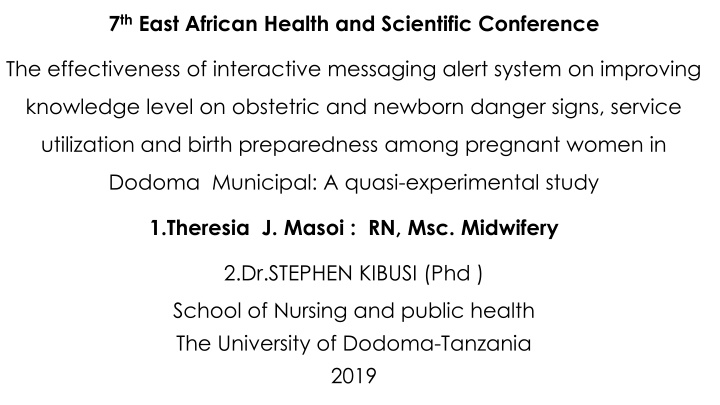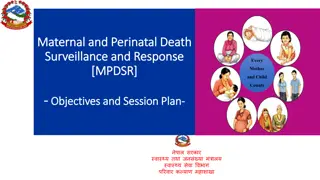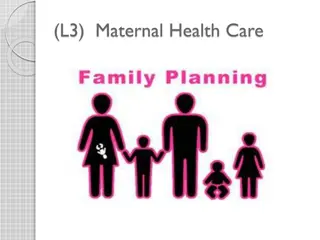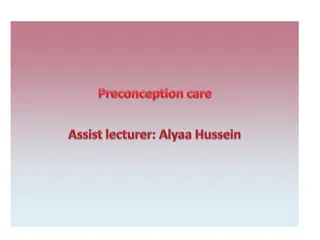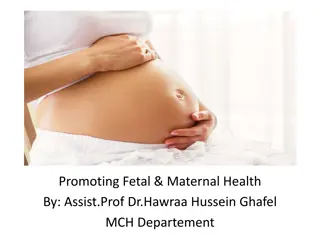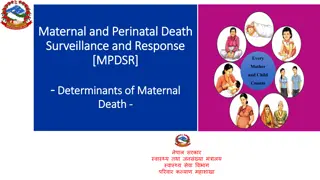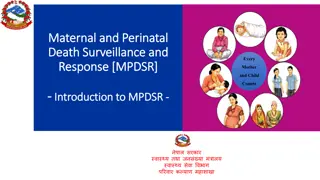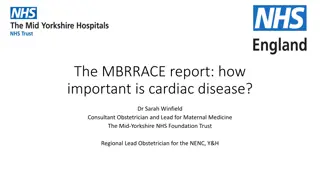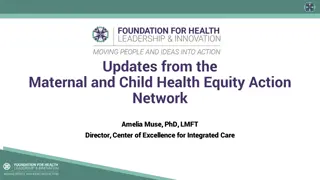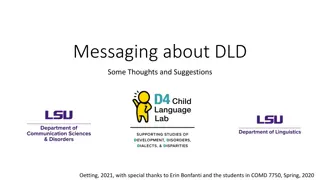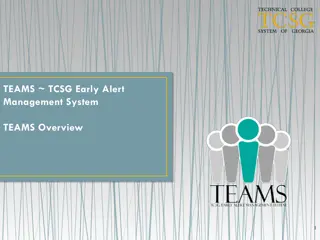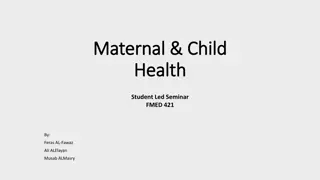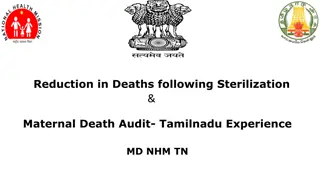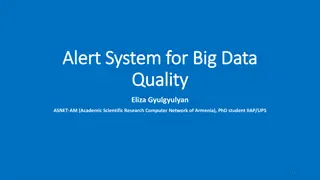Effectiveness of Interactive Messaging Alert System in Improving Maternal Health Knowledge
This study evaluates the impact of an Interactive Messaging Alert System (IMAS) on enhancing knowledge levels of obstetric and newborn danger signs, increasing antenatal care service utilization, and improving birth preparedness among pregnant women in Dodoma Municipal. By addressing the three core strategies for reducing maternal and early neonatal deaths, the research aims to improve maternal and child health outcomes through innovative technology solutions.
Download Presentation

Please find below an Image/Link to download the presentation.
The content on the website is provided AS IS for your information and personal use only. It may not be sold, licensed, or shared on other websites without obtaining consent from the author.If you encounter any issues during the download, it is possible that the publisher has removed the file from their server.
You are allowed to download the files provided on this website for personal or commercial use, subject to the condition that they are used lawfully. All files are the property of their respective owners.
The content on the website is provided AS IS for your information and personal use only. It may not be sold, licensed, or shared on other websites without obtaining consent from the author.
E N D
Presentation Transcript
7thEast African Health and Scientific Conference The effectiveness of interactive messaging alert system on improving knowledge level on obstetric and newborn danger signs, service utilization and birth preparedness among pregnant women in Dodoma Municipal: A quasi-experimental study 1.Theresia J. Masoi : RN, Msc. Midwifery 2.Dr.STEPHEN KIBUSI (Phd ) School of Nursing and public health The University of Dodoma-Tanzania 2019
Background 1/2 Appropriate utilization of antenatal care can prevent complications and ensures better maternal and child health care Ensures early detection and management of antenatal risk factors, birth preparedness and complication readiness Three core health sector strategies for reducing maternal and early neonatal deaths: Comprehensive reproductive health care; Skilled care for all pregnant women and Emergency obstetric care for all women and infants with life-threatening complications (World Health Organization, 2016) 1
Background 2/2 The underlying determinants of maternal death during pregnancy, childbirth and postpartum are affected by the three-delay; Identifying a life threatening event/danger signs and making the decision to go to the health facility Delay in reaching the health facility and Delay in receiving appropriate and adequate care at the health facility So this study aimed at testing the effectiveness of interactive messaging alert system on improving knowledge level on obstetric and newborn danger signs, service utilization, birth preparedness and complication readiness among pregnant women in Dodoma municipal 2
RESEARCH OBJECTIVES Broad objective: To evaluate effectiveness of the interactive messaging alert system in improving knowledge on obstetric and newborn danger signs, Antenatal care service utilization and individual birth preparedness and complication readiness among pregnant women in Dodoma municipal. Specific Objectives: 1.To assess the effectiveness of an IMAS on improving the level of knowledge on obstetric and newborn danger signs among pregnant/postnatal women. 2.To test the effectiveness of IMAS on improving individual birth preparedness and complication readiness among pregnant/postnatal women in Dodoma Municipal. 3. To evaluate the effectiveness of IMAS on improving utilization of the recommended antenatal care services among pregnant/postnatal women in Dodoma Municipal. 3
METHODOLOGY 1/2 Study design: A quasi-experimental, with a control group using quantitative research approaches. Pregnant women were followed from their first visit to the point of delivery. Knowledge on key danger signs, service utilization and birth preparedness were assessed at baseline and after delivery for both groups Study area: Dodoma Municipality(six health facilities (among the region with high maternal mortality) Study population: Pregnant/postnatal women who started their first antenatal visit below the first twenty weeks. Sampling technique: Purposive sampling (to select Dodoma region, Dodoma Municipal and the health facilities). The study participants were selected Randomly both intervention and control. Sample size: 450 participants (n = 150 intervention, n = 300 control).The intervention were matched to control by age, gravidity and education level at a ratio of 1:2 Data collection tools: StandardizedSemi-structured Questionnaires, mobile phones and computerized database were used 4
METHODOLOGY 2/2 Definitions of variables Dependent variables: Knowledge on obstetric and newborn danger signs, Antenatal Care service utilization, Individual Birth preparedness and complication readiness Independent variable: Interactive messaging alert system(IMAS) and the Covariates : Parity, Age, Gravidity, education level and marital status Analysis: Analysis of covariance (ANCOVA),T test and simple and multiple linear regression were used to test the effectiveness of the intervention 6
The Intervention 1/5 Specially designed software automatically generated and sent health education text messages according to women s gestation age Key features of the intervention Computerized database Automated messaging Interactive messaging Linkage of ANC data to labor and delivery care All the communication were recorded to the system database to identify the patterns of messages and the frequently asked questions 5
The Intervention 2/5 There were a total of 5400 messages sent to pregnant women and recorded in the system between March, 2018 to June, 2018 equivalent to 12 messages per participant with the feedback of 96.5% of pregnant mother texted back for appreciation or texted to ask questions. There was a password that protected web user interface and enabled every user to access only the information required at his /her position in the system. So every user was assigned an account. 6
The flow chart diagram which depicts the flow of data and information in and outside the system 3/5 7
logical flow diagram which show how this SMS module for two ways worked 4/5 8
DEMOGRAPHIC AND OBSTETRIC CHARACTERISTICS (N=450) VARIABLE Intervention n Control Total/out of 450 n X2 P-value 3.256a 0.196 % n % % Age <20 yrs 20-34 yrs 35 yrs 21 111 18 14.0 74.0 12.0 61 212 27 20.3 70.7 9.0 82 323 45 18.2 71.8 10.0 1.928a 0.381 Education status Primary education Secondary education College/University 82 52 16 54.7 34.7 10.6 182 95 23 60.7 31.7 7.6 264 147 39 58.7 32.7 8.6 2.616a 0.106 Gestation age at 1st visit 1-12 weeks 13-20 weeks 56 94 37.3 62.7 136 164 45.3 54.7 192 258 42.7 57.3 33 22.0 64 217 19 21.3 97 21.6 72.4 6.0 0.189a 0.910 Gravidity 2-4 5 1 109 8 72.7 5.3 72.3 6.4 326 27 10
Overall scores on level of knowledge, IBPACR and ANC service utilization (N=450) Before intervention After intervention VARIABLE Control Intervention Control Intervention Knowledge Adequate knowledge Inadequate knowledge 144 (48.0%) 156 (52.0%) 134 (44.7%) 166(55.3%) 69 (46.0%) 81 (54.0%) 116 (77.3%) 34 (22.7% ) IBPACR Prepared Not prepared 51 (17.0%) 249 (83.0%) 30 (20.0%) 120 (80%) 89 (29.7%) 211 (70.3%) 106 (70.7%) 44 (29.3%) ANC service utilization Received adequate services Received inadequate services 173 (57.7%) 127 (42.3%) 116 (77.3) 34 (22.7%) Total n= 300 150 300 150 11
Ancova results to compare the mean change on Knowledge of obstetric and newborn danger signs,IBPACR and ANC service utilization between Intervention and controls (N=450) Before intervention After intervention P-value Cohen s d Effect size Variables Interv. Control Interv. Control X Sd X Sd P-val. X Sd X Sd Knowledge 4.78 3.227 4.71 3.382 0.826 9.531 2.666 6.518 4.304 <0.001 0.85 IBPACR 1.97 1.102 1.95 1.205 0.887 4.17 1.365 2.631 1.778 <0.001 0.9 2.77 0.420 2.58 0.495 <0.001 0.414 ANC utlz 12
Conclusion and recommendation The study findings of this study have revealed that Interactive messaging alert system yields better outcome to participants in the intervention group, in the part of health education as compared to conventional Antenatal care health education provided in our Antenatal care clinics. Level of knowledge, Individual birth preparedness and Antenatal care service utilization was higher in the intervention group compared to the control group. This may help in reducing the effect caused by the first and second delay too. Policy makers and planners in health related issues, should integrate a two- way communication systems in our Antenatal care clinics . 13
Acknowledgement The project team would like to express its sincere thanks to the University of Dodoma management for sponsoring this important project. Without the grant offered by UDOM this work would have been impossible The System is now online at ( http://dodoma-antinetal-pns.or.tz ) 14
References 1. World Health Organization. WHO Maternal mortality Fact sheet. Geneva: media centre; 2016. 2. Ministry of Health Community Development Gender Elderly and Children (MoHCDGEC) [Tanzania, Mainland]. Tanzania Demographic and Health Survey and Malaria Indicator Survey (TDHS-MIS) 2015-16. Dar es Salaam, Tanzania, and Rockville, Maryland, USA; 2016. 3. Heredia-Pi IA, Servan-Mori E, Darney BG, Reyes-Morales H, Rafael Lozano. Measuring the adequacy of antenatal health care a national cross-sectional study in Mexico. Mexico: World Health Organization (WHO); 2016. 4. Xiong K, Kamunyori J, Sebidi J. The MomConnect helpdesk: How an interactive mobile messaging programme is used by mothers in South Africa. BMJ Glob Heal. 2018; 5.Ngabo F, Nguimfack J, Nwaigwe F, Mugeni C, Muhoza D, Wilson DR, et al. Designing and Implementing an Innovative SMS-based alert system (RapidSMS-MCH) to monitor pregnancy and reduce maternal and child deaths in Rwanda. Pan Afr Med J. 2012;13:31. 6.Lund S, Hemed M, Nielsen BB, Said A, Sadick K, Makungu MH R V. Mobile phones as a health communication tool to improve skilled attendance at delivery in Zanzibar a cluster-randomised controlled trial. Zanzibar: PubMed; 2012. 16
